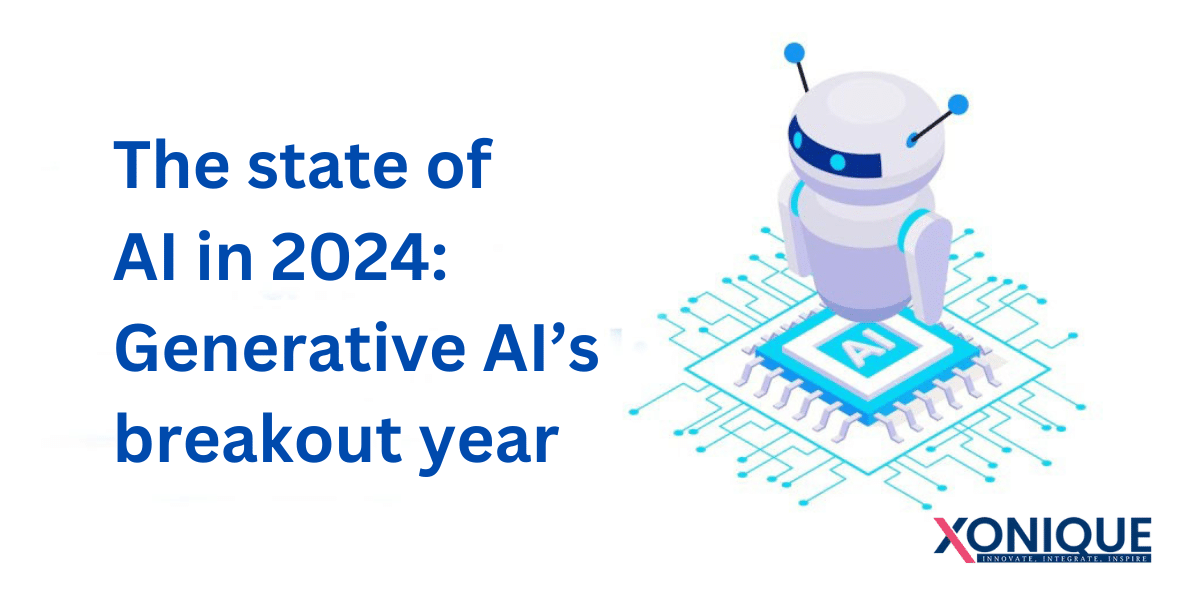In 2024, Artificial intelligence (AI) is undergoing the most radical shift in its development due to the rapid use of generative AI tools. These cutting-edge technologies aren’t limited to only the tech sector but have penetrated all industries, changing how businesses operate. AI promises to quickly boost teams’ capacity to develop new services and apps. Companies should recognize both the tangible benefits and associated risks posed by AI technology for business use, including its effects on their workforce.
These companies with integrated AI capabilities were the first to investigate Gen AI’s possibilities and those who see the most benefit from conventional AI capabilities. They are already ahead of others when it comes to implementing Gen AI instruments. The expected business disruption caused by the emergence of Generative AI Development Services will be significant, and most respondents anticipate substantial adjustments to their workforces. They expect reductions in the workforce in specific areas and massive shifts in training to meet changing talent requirements. While the application of Gen AI could encourage various AI technologies, we have seen little evidence of significant growth in the organizations adopting this technology.
However, the question is on everyone’s mind: What’s beyond the surface? Although AI has shaken the work environment’s foundations in the past year, the truth is that we’ve barely begun to scratch the level of what’s possible.
What will 2024 bring for generative AI? Here’s what we think.
What Is Generative AI?
Generative AI is an innovative technology that lets machines produce new content like images, text, and music that resemble human-made creations. Contrary to conventional AI that follows predefined patterns and patterns, Generative AI makes use of advanced algorithms and neural networks to create new material. This revolutionary approach allows machines to gain knowledge from massive data sets and produce various results, making it a revolutionary factor in artificial intelligence.
Emergence Of Multimodal AI Models
OpenAI’s GPT4 and Meta’s Llama 2 were instances of advancements in large-language models. The technology extends beyond texts by using multimodal models that allow users to mix and match information based on audio, text images, video, and text to generate fresh information. This method combines information, including texts, images, and speech, using advanced algorithms that make predictions and produce results.
In 2024, multimodal AI is predicted to develop rapidly, leading to the development of generative artificial intelligence capabilities. These capabilities are advancing over the conventional single-mode function by incorporating various data types, including images, text, and audio. Because of the shift to multimodal models, AI is expected to become more intuitive and fluid.
Benefits Of Generative AI Technology
Generative AI systems offer various advantages. Here’s a look at the most effective enhancements that generative AI can provide.
Enhanced Creativity And Innovation
Generative AI boosts creativity by creating innovative and creative media. It allows designers, creators, and artists to break away from conventional trends and discover new concepts.
Through generating various outputs, ranging from artwork to music and everything in between, generative AI creates ideas for new and innovative concepts that may never have been imagined in the past. Technology serves as a catalyst to push boundaries and change the design world.
Automation Of Repetitive Tasks
Generative AI is a master at making monotonous tasks more accessible, freeing human resources for more incredible strategic and complicated tasks. When creating product descriptions, emails, or layouts, Generative AI’s ability to generate content on a mass scale of a business can save time and cut down on labor-intensive tasks. Automation improves productivity and efficiency across different sectors, allowing professionals to concentrate on more critical tasks.
Personalization And Customization
Generative AI allows for personalizing experiences by tailoring content to user preferences. From personalized marketing strategies to product recommendations curated by the manufacturer, this technology uses information to produce content resonant for each customer. Personalization increases user interaction and happiness and, in turn, results in various situations.
Optimizes Product Designs
Designing products is another area where AI could help businesses increase efficiency and creativity. It’s sometimes difficult to know what consumers want, as behavior and preferences can change over time, leaving companies scrambling to stay ahead. AI assists in analyzing huge quantities of data. AI models employ deep-learning techniques to discern market patterns and analyze market aspects, helping companies build greater confidence in their decision-making and decrease risks. This data could provide insight into consumer behavior, which your company can utilize to create new products and improve your current offerings.
When you know where your customers tend to be and where their preferences are changing, utilize AI to develop new ideas. Include some of the latest problems that consumers are facing and possible solutions. You can also consider adjustments to your product offerings that will make them more attractive in the current market conditions.
Improved Decision-Making Processes
Generative AI helps decision-making by providing different scenarios and possible solutions based on the available data. This is particularly useful for business strategies, problem-solving, and risk analysis. With diverse viewpoints and generative knowledge, AI allows decision-makers to make better-informed and balanced selections. Generative AI is poised to transform industries and change how we think about innovation, automation, personalization, and decision-making. Its numerous benefits highlight its value in the developing field of artificial intelligence.
Enhances Efforts To Combat Cybercrime
Generative AI can help businesses improve their cybersecurity strategies. Companies must be able to analyze huge amounts of data to identify security threats, and AI tools can aid in this process. It is still possible for human beings to analyze the flow of information through computers; the process requires a significant amount of time and effort to complete correctly. IT experts can use AI for different tasks. AI assists you by analyzing the data on your behalf and uncovering patterns that are different from the norm. If you notice something isn’t quite suspicious, AI can inform your team that a threat needs to be addressed.
This strategy allows swift detection of threats and the ability to stop criminal actors from compromising your systems. As cyber-attacks begin to use more AI, this approach will become essential for keeping pace with the latest threats, which use generative AI to generate fresh malware and personalized attacks that rely on phishing.
Foster’s Market Innovation
Businesses looking to establish an impact in their field could use the power of generative AI to aid in the process. By analyzing large quantities of information and data, these generative AI tools provide insights into data that humans might not be able to discover independently. Businesses will benefit from more incredible market innovation. AI aids companies in finding new ways to grow their business. It can identify new products in development, new service possibilities, possible market shifts, and valuable information.
Alongside helping firms learn more about their markets, AI will also help reduce innovation risks. You need to understand the information available to access all the data required to make the right decisions. The data you gather through AI analysis will help you reduce your chance of developing innovative products, as you will know consumers’ preferences. The information you gather will also provide a more accurate picture of whether your targeted customers will receive your concept, giving your company a competitive edge.
What To Expect In 2024
Businesses have been buying AI expertise quickly to stay on top of trends. Certain companies are also expecting significant changes in their workforce in the coming three years. That includes the 8% belief that AI could result in a greater than 20% reduction in staff. Let’s look at what the state of AI will be like in the year 2024.
Widespread Adoption Across Industries
Many companies have incorporated intelligent AI into their business operations in the past year, indicating an increasing use. These Generative AI Applications can improve sales and marketing, innovate product design, and improve customer service processes.
Enterprises Will Adopt Smaller, Open-Source AI Models
The shift to smaller, open-source AI models is expected to be a significant trend over the next year. The creation of these models requires computing resources that are not accessible to the majority of researchers or companies. The result was efforts to rebuff the rationale behind increasing the size of.
AI models are shrinking in size, and they are released as open source to be made available to businesses of all sizes. By 2024, this could be the year of AI adoption. Businesses will improve the models or create AI software customized to their users’ needs and not rely on access to APIs from platforms that hold monopolies over the model.
Workforce Dynamics: Reskilling And New Roles
One of AI’s significant effects is its impact on the workforce. Although computers are replacing some jobs, the focus is on training and upgrading workers and Hire Generative AI Engineers to use AI’s capabilities efficiently. A new set of job fields, including prompt engineering, is emerging and illustrating how work is changing in an era of artificial intelligence.
Shadow AI Causes A Fresh Flood Of Data Breaches
Currently, 60 percent of employees are using illegal AI tools that can boost efficiency and productivity. In the sense of unauthorized, the tools aren’t approved or monitored by the IT or security department. This is a problem because it increases the likelihood of information leakage and compliance violations. Since AI software cannot see employees’ shared information, security personnel cannot block or conceal sensitive information from becoming vulnerable.
To make the issue even more alarming, it’s important to remember the importance of input prompts and responses. These can be crucial in improving and training AI models. Therefore, data input into such systems could reappear as output when a different user responds to a prompt. This means that a data breach is possible at any time. The company will not be better informed until it’s too late.
Do you think your company needs a clearer understanding of its data-related environment? You’re mistaken. Unstructured data, which covers anything from Slack messages and Facebook posts, accounts for less than one-third of all data handled by companies. Experts predict that in 2024, generative AI subsets, such as the natural process of language (NLP), can enable companies to boost their capability in handling non-structured information.
This is the dawn of a new age of marketing and customer satisfaction team opportunities. Artificial intelligence will allow those departments to access a treasure trove of unattainable insights, identify emerging trends and patterns, and take data-driven actions to boost performance. In parallel, compliance and cybersecurity teams are set to benefit from the capabilities of NLP. The technology is expected to transform how organizations identify how to classify, categorize, and protect the cloud’s unstructured information apps such as Teams and Google Workspace.
In the past few years, methods for analyzing data have been unable to recognize unstructured data. This is because the data is stored all over the place in servers, cloud infrastructures, and other third-party programs and does not adhere to a predefined format.
With traditional methods, identifying and categorizing the right information was nearly impossible, increasing the risk of unintentional data breaches and data theft. However, modern NLP-based solutions can easily identify, monitor, and trace inaccessible information. This makes it much easier for cyber risk experts to ensure that personal data is only accessible and utilized by users correctly.
Adopting AI Securely
2024 will be the year specific AI successful strategies are revealed. These strategies will see particular types of products and features dominating the market while other features disappear. The companies will determine which experimentation routes will be successful and what features and products they will look at.
Companies must establish transparency in using AI services to navigate and implement AI tools on the cloud. Gain an understanding of AI use of products and services in your company to remove blind spots. This will let you know what teams use AI within your company and their services and products to ensure that development and experimentation use the best security standards.
They need to create an attitude of ownership. In the cloud-based operating model, security personnel should work closely with cloud experts, and AI professionals to deal with the ever-changing attack surfaces created via AI tools. Promoting a more open and transparent security culture throughout the company is ideal. This suggestion has never been more vital in the current climate of increasing AI adoption.
Security Breaches Are Now The Top Threat
With much of the activity currently occurring in Software as a Service (SaaS) software, identity compromise could become the most common method malicious attackers use in 2024. Instead of focusing on zero-day vulnerabilities and ransomware, malicious actors are more likely to use compromised identities to gain the access privileges they confer. The rise in identity-based attacks will require increased investment in zero-trust infrastructure, such as tools and policies that block or permit access to users in real-time. Mainly depending on their behavior and the possibility of suspicious activity.
Looking ahead to the coming year, artificial intelligence will enormously impact the workplace. However, to use this rapidly growing technology, companies must be able to balance AI technology with compliance and security.
The Future Of AI
The future direction of AI is boundless in its possibilities. We anticipate increasing investment and a more advanced application of these tools. AI technologies are ever-evolving, which makes keeping abreast of developments essential for businesses and professionals alike.
The effect of generative AI across various sectors Here are some industries that you can further discuss:
Healthcare
AI can transform healthcare, enabling better diagnoses and recognizing conditions like cancer through more precise scanning images than traditional techniques. AI algorithms can also be employed to design specific treatment plans based on the patient’s genetic profile, enhancing treatment efficiency.
Finance
Generative AI For Finance is revolutionizing risk analysis. It uses vast quantities of information to determine the possibility of fraud and risks quicker than before. In addition, AI-driven chatbots and virtual assistants offer individual financial advice, boosting customer service.
Retail
Retailers employ AI to create individual shopping experiences. It uses algorithms that analyze customer data and suggest the best products. AI can also improve the management of inventory by anticipating the trends in demand and helping with the design of new products that are in line with consumer preferences.
Manufacturing
AI is used to manufacture products, which results in significant efficiency improvement. This is all thanks to predictive maintenance techniques that reduce the time between equipment breakdowns by anticipating their causes. Quality control systems that AI drives ensure better quality products and more remarkable sameness.
Education
AI can personalize education by adapting teaching materials tailored to every student’s unique learning requirements, offering engaging and purposeful lessons. Automated systems for grading save teachers time and allow them to concentrate on their teaching.
Transportation and Logistics
AI improves delivery routes to reduce fuel use and speed up delivery time in this area. AI is also improving transportation safety by anticipating potential dangers and avoiding them.
Entertainment and Media
AI is utilized to create innovative content for music or film, such as music or script concepts. AI also powers recommendation engines for streaming platforms, providing viewers with individual content recommendations.
Life Sciences
AI can be used for genome and gene editing, helping scientists learn more about genetic disorders and develop specific treatments. Analyzing large data sets with AI will also help speed up the discovery of biomarkers for diverse diseases.
Automotive
AI is vital to the development of autonomous cars in the automobile sector. It is also employed for predictive maintenance, process optimization in manufacturing, and personalizing the journey for passengers and drivers.
Semiconductor
AI plays a significant function in enhancing the manufacturing of semiconductors and increasing the accuracy and efficacy of making chips. AI is also used in the design of better and more efficient chips.
Pharmaceuticals
AI has revolutionized drug research and development within the pharmaceutical sector, drastically cutting the time and money needed to bring innovative medicines to the market. AI algorithms are also utilized to anticipate drug effects and interactions.
These cases illustrate the range of AI applications and their capacity to spur improvement and improve efficiency in various technological industries.
Conclusion
The growth path for generative AI is promising and holds enormous potential to impact businesses and our daily lives. Integrating generative AI in creating content programming and other areas shows its diverse abilities. As AI models advance, collaborating with AI systems to generate unique and beneficial results will become second nature. However, the advent of technology that produces AI can also bring forth ethical issues, such as control and biases in AI-generated content. The balance between creativity and ethics should form the basis of AI development for long-term sustainability.
In this year’s calendar, we see that AI generative is likely to continue exerting an enormous impact on our work environment. The balance between creativity and ethics should form the basis of AI development for long-term sustainability. Therefore, 2024 is expected to become the decade when AI becomes more widespread. It will be able to drive actual applications in organizations and develop new formats for content. It will also comprehend a greater variety of languages, enhance interactions, and provide reasoning and algorithms for problem-solving that look human.











